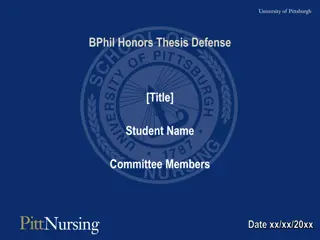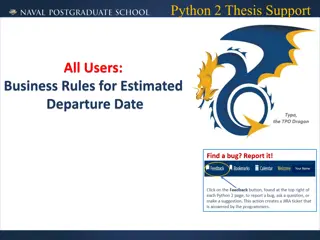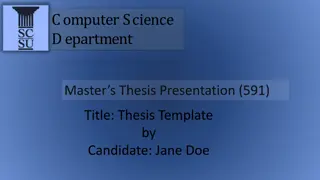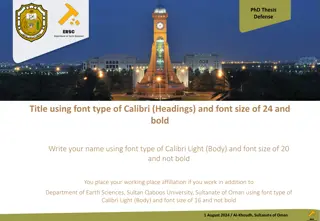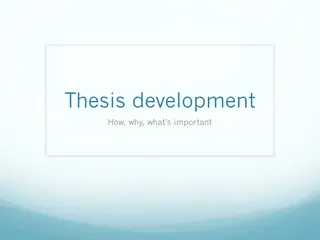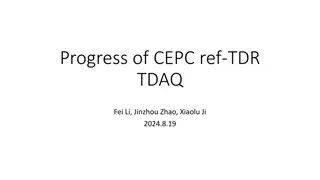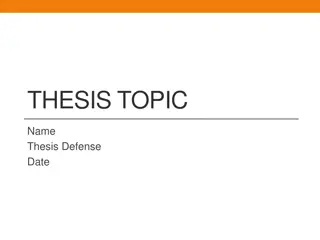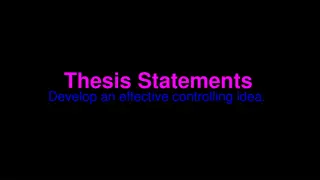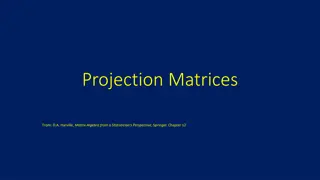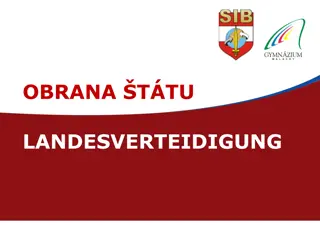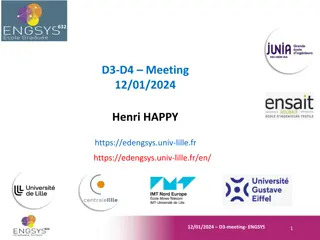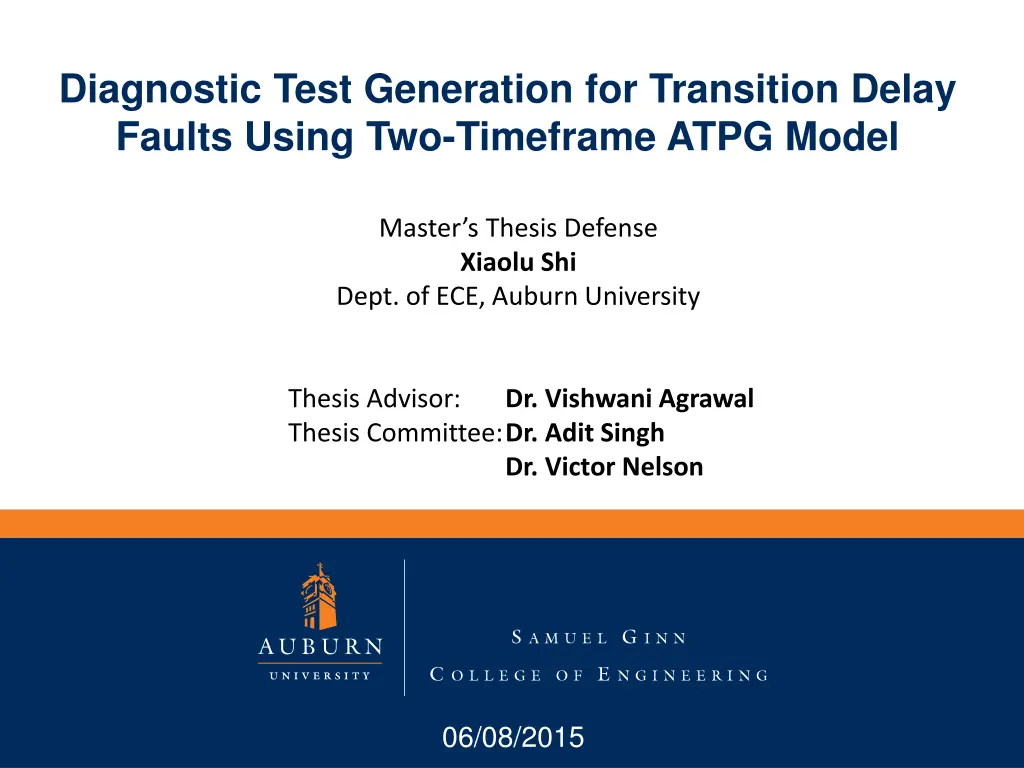
Diagnostic Test Generation for Transition Delay Faults in VLSI: Thesis Defense Insights
Explore the intricacies of diagnostic test generation for transition delay faults in VLSI through a detailed thesis defense by Xiaolu Shi from Auburn University. Discover the background, problem statement, system overview, experimental results, conclusions, and future work in this comprehensive study. Gain insights into fault simulation, error propagation tracing, fault diagnosis algorithms, fault dictionaries, and diagnostic metrics in VLSI testing.
Download Presentation

Please find below an Image/Link to download the presentation.
The content on the website is provided AS IS for your information and personal use only. It may not be sold, licensed, or shared on other websites without obtaining consent from the author. If you encounter any issues during the download, it is possible that the publisher has removed the file from their server.
You are allowed to download the files provided on this website for personal or commercial use, subject to the condition that they are used lawfully. All files are the property of their respective owners.
The content on the website is provided AS IS for your information and personal use only. It may not be sold, licensed, or shared on other websites without obtaining consent from the author.
E N D
Presentation Transcript
Diagnostic Test Generation for Transition Delay Faults Using Two-Timeframe ATPG Model Master s Thesis Defense Xiaolu Shi Dept. of ECE, Auburn University Thesis Advisor: Thesis Committee: Dr. Vishwani Agrawal Dr. Adit Singh Dr. Victor Nelson 06/08/2015
Acknowledgment Prof. Vishwani Agrawal for his continuous guidance throughout my work, he is always encouraging and supportive Prof. Adit Singh and Prof. Victor Nelson for being my committee members, for their courses, and their patient guidance 2
Presentation Outline Background Problem Statement Diagnostic Automatic Test Generation System Exclusive Test Generation for Transition Delay Fault Experiment Results Conclusion and Future Work 3
VLSI Testing Test Vectors/ Patterns Circuit Under Test (CUT) Fault-free Circuit Compare Faulty Circuit Expected Output Responses 4
VLSI Diagnosis Effect-Cause Algorithm Traces back the error propagation path from failing POs by multiple methods Fault simulation on suspected faults Compare the failing response and rank faults Remove low ranking suspects and narrow down the failure location 5
VLSI Diagnosis Cause-Effect Algorithm Pre-simulated failing responses of all modeled faults stored in a dictionary Fault simulation on defective circuit Compare circuit failing response with previous stored data Search which fault might be the cause of the failure 6
Fault Dictionary Full Response Dictionary Complete record of failing information at each output for all fault-vector pairs Pass/Fail Dictionary Only stores the single pass or failing pattern index for each fault-vector pair 7
Diagnostic Metrics Fault coverage (FC) is a quantitative measure of the effectiveness in detection test. Fault coverage =Number of detected faults Total number of faults Diagnostic coverage (DC) metric evaluates the effectiveness of a given set for fault diagnosis. A fault group contains two or more undistinguished faults (equivalent with respect to the test vectors) Diagnostic coverage =Number of detected fault groups Total number of faults 8
Design for Test (DFT) Insert internal scan circuitry to construct full-scan circuit Memory elements consist of one or more scan chains to hold the previous value and state Controllability and observability 9
Problem Statement Construct effective two-timeframe ATPG model Generate additional test vectors to distinguish fault pairs Improve diagnostic coverage of transition delay faults 10
Automatic Exclusive Test Generation System (cont.) Blocks 1 and 2 are conventional ATPG system for detection test using Fastscan tools Generate a detection test set Calculate fault coverage Construct fault dictionary. 12
Automatic Exclusive Test Generation System (cont.) Block 3 is diagnostic fault simulator Group faults with same fault signature Calculate and update diagnostic coverage (DC) Identify undiagnosed fault groups and target fault pairs If all faults in groups are targeted, the diagnosis will stop 13
Automatic Exclusive Test Generation System (cont.) Block 4 is exclusive test generator Exclusive test is defined as a test vector that can detect exactly one fault but not the other from the targeted fault pair Work on an undistinguished fault pair. If no exclusive test exists, then the two faults are functionally equivalent, i.e., no test exists to distinguish them. 14
Modeling a transition delay fault Modeling slow-to-rise fault Modeling slow-to-fall fault a modeling flip-flop (MFF) and an AND gate propagate slow- to-rise fault from ? to ? when apply 01 a modeling flip-flop (MFF) and an OR gate propagate slow- to-fall fault from ? to ? when apply 10 *Zhang, Yu, and V.D. Agrawal, Reduced Complexity Test Generation Algorithms for Transition Fault Diagnosis., ,in 2011 IEEE 29th International Conference on Computer Design (ICCD),96- 101, 2011. 15
Single Timeframe ATPG Model A single-circuit-copy ATPG model where X1 represents fault free circuit, X2 models slow-to-rise fault. A test for stuck-at fault on select signal line y detects the slow-to-rise fault on line x to x . 16
Single Timeframe ATPG Model the test on y s-a-0/1 is an exclusive test for a transition delay fault pair 17
Sequential ATPG & Combinational ATPG Sequential ATPG requires a sequence of vectors and is also restricted to previous value and state. Has limited controllability and observability of internal signals. Combinational ATPG is able to test a single fault and generate test vector without considering the duplicated circuit with multiple faults. The complexity of a combinational ATPG for detecting redundant faults is much lower than sequential ATPG. 18
Test Generation Modes Launch off Capture (LOC) Apply first vector V1 which is shifted through scan flip- flops (SFFs), and capture output in SFFs as the second scan input vector. Our work utilizes LOC test generation mode. Launch off Shift (LOS) Ignore the output V2, the second vector comes from V1 shifted one bit and adds one more single scan-in bit. LOS mode also can be developed in this diagnostic automatic test generation system. 19
A New Two-Timeframe Model for Combinational ATPG Two-timeframe expansion ATPG model of transition delay fault for exclusive test under LOC test mode 20
A Simplified Model As test vector pair under LOC transition delay test. The first vector only initializes the circuit and will not have any effect on the logic, so the model can be simplified as shown. *LOS mode can be also developed to construct two-timeframe ATPG model *Yu Zhang, Bei Zhang, and Vishwani D. Agrawal. Diagnostic Test Generation for Transition Delay Faults Using Stuck-At Fault Detection Tools. J. Electron. Test. 30, no. 6 (December 2014): 763 80. 21
Exclusive Test Generation Example ISCAS89 s27 benchmark circuit: Target fault pair: f2 [slow-to-fall, G1] f9 [slow-to-rise, NOR2_2/OUT] 22
Exclusive Test Generation Example of two-timeframe expansion of s27 and ATPG model for specified transition delay fault 23
Diagnostic Fault Simulation Transform the generated combinational vector into a sequential test vector-pair Fault simulation on original full-scan sequential benchmark circuit Calculate the new DC, update undistinguished groups and built a new dictionary. The diagnostic fault simulator will stop after all undistinguished fault pairs are targeted or an adequate DC has been achieved. 24
Experimental Results Detection Test (by Fastscan) Diagnostic Test (by Fastscan) No. of TDFs No. of Det. Test Vectors FC (%) No. of Undist. Pairs DC (%) No. of Diag. Test Vector Pairs DC (%) CPU* Time (sec.) Circuit No. of Undist. Pairs s27 46 11 100.0 29 54.3 17 1 100 12.9 s298 385 44 79.9 106 62.4 28 47 77.7 44.2 s420 622 113 85.4 429 54.9 47 170 81.0 155.1 s526 570 86 62.5 226 47.8 28 98 58.1 52.1 s838 1254 231 83.6 895 53.3 95 356 78.5 539.8 s1423 2199 114 92.0 355 80.5 73 199 92.1 279.3 s5378 6007 230 90.6 877 83.1 340 98 91.0 1879.8 *Hardware configuration: 2.6GHz CPU, 3.86GB RAM, Intel Core i5 25
Comparing Detection Test and Diagnosis Test A clear decrease of Undistinguished fault pair after two-timeframe expansion ATPG model based exclusive test generation 900 800 No. of Undistinguished Fault Pairs 700 600 500 No. of Undistinguished Fault Pairs for Detection Test 400 300 200 No. of Undistinguished Fault Pairs for Diagnostic Test 100 0 s27 s298 s420 s526 s838 s1423 s5378 26
Comparing Detection Test and Diagnosis Test DC improvement achieved after two- timeframe expansion ATPG model based exclusive test generation 100 90 Diagnostic Coverage (%) 80 70 60 50 40 DC for Detection Test (%) 30 20 DC for Diagnostic Test (%) 10 0 s27 s298 s420 s526 s838 s1423 s5378 27
Comparison with Previous Work No. of Test Vector (det.+Diag.) (A) 28 (B) 28 (A) 72 (B) 70 (A) 187 (B) 192 (A) 570 (B) 603 No. of Unidist. groups 1 1 39 39 174 182 84 85 Largest Groups size 2 2 4 4 5 5 7 7 No. of Undist. Pairs 1 1 47 80 199 208 98 99 Diag. CPU Time* (sec.) 12.9 29 44.2 55 279.3 845 1879.8 488 DC (%) Circuit 100 97.8 77.7 70.1 92.1 84.2 91.0 89.6 s27 s298 s1423 s5378 *The detection test CPU time is approximately 5-10% that for Diagnostic test (A) This work, two-timeframe ATPG model, 2.0GHz CPU, 1885MB RAM, x86 Linux (B) Previous work, single timeframe ATPG model, 2.6GHz CPU, 3.86GB, Intel Core i5 *Yu Zhang, Bei Zhang, and Vishwani D. Agrawal. Diagnostic Test Generation for Transition Delay Faults Using Stuck-At Fault Detection Tools. J. Electron. Test. 30, no. 6 (December 2014): 763 80. 28
DC (%): Comparison with Previous Work DC for single-timeframe ATPG model (B) An obvious DC improvement with two- timeframe expansion ATPG model based exclusive test generation DC for two-timeframe ATPG model (A) 100 97.8 92.1 91 89.6 84.2 77.7 70.1 Combinational ATPG has lower complexity for identifying redundant faults and generating exclusive tests s27 s298 s1423 s5378 *Hardware configuration (A): 2.0GHz CPU, 1885MB RAM, x86 Linux Hardware configuration (B): 2.6GHz CPU, 3.86GB RAM, Intel Core i5 29
Conclusion A diagnostic automatic test generation system relies on exclusive tests to distinguish transition delay fault pairs Experimental results show that diagnostic coverage (DC) improves after two-timeframe expansion ATPG model for exclusive test is used Combinational ATPG is more effective for redundant fault identification and exclusive test generation 30
Future Work Implement two-timeframe model for LOS test generation mode to get higher DC Test set compaction to reduce test application time Library size reduction techniques combined with this test generation system will make delay fault diagnosis more efficient Utilization of this two-timeframe model to stuck open fault diagnostic test 31
References Abramovici, Miron, Melvin A. Breuer, and Arthur D. Friedman. Digital Systems Testing & Testable Design. edition 1. New York: Wiley-IEEE Press, 1994. Lavo, D.B., and T. Larrabee. Making Cause-Effect Cost Effective: Low-Resolution Fault Dictionaries. In Proc. International Test Conference, 2001, pp. 278 86. Zhang, Yu, and V. D. Agrawal. A Diagnostic Test Generation System. In Proc. International Test Conference, 2010, pp. 1 9. Zhang, Yu, Bei Zhang, and V. D. Agrawal. Diagnostic Test Generation for Transition Delay Faults Using Stuck-At Fault Detection Tools. J. Electron. Test. 30, no. 6 pp. 763 80, December 2014. Lavagno, Luciano, Grant Martin, and Louis Scheffer. Electronic Design Automation for Integrated Circuits Handbook - 2 Volume Set. Boca Raton, FL, USA: CRC Press, Inc., 2006. Grout, Ian A. Integrated Circuit Test Engineering: Modern Techniques. Springer Science & Business Media, 2005, pp. 68-70 Agrawal, V. D., Dong Hyun Baik, Yong Chang Kim, and K. K. Saluja. Exclusive Test and Its Applications to Fault Diagnosis. In Proc. 16th International Conf. VLSI Design, 2003, pp. 143 48. M. L. Bushnell and V. D. Agrawal, Essentials of Electronic Testing for Digital, Memory & Mixed- Signal VLSI Circuits, Boston, Springer, 2000. Park, Intaik, and E.J. McCluskey, Launch-on-Shift-Capture Transition Tests., Proc. International Test Conference, 2008, pp. 1-9. Higami, Y., Y. Kurose, S. Ohno, H. Yamaoka, H. Takahashi, Y. Shimizu, T. Aikyo, and Y. Takamatsu, Diagnostic Test Generation for Transition Faults Using a Stuck-at ATPG Tool, , Proc. International Test Conference, 2009, pp. 1-9. 32
Thank you! Questions ?

